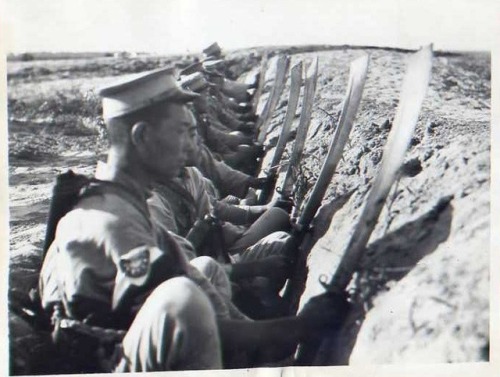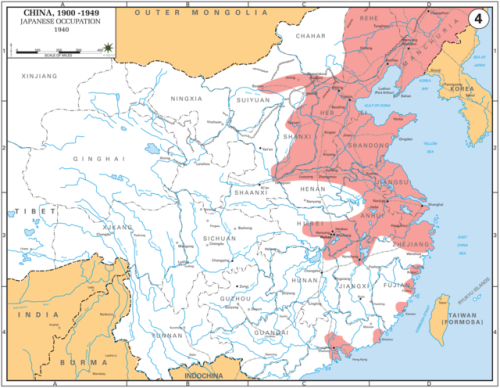World War II and the Forgotten Ally,Recently I’ve noticed some posts circulating around the interweb
World War II and the Forgotten Ally,Recently I’ve noticed some posts circulating around the interwebs debating the role different nations played in World War II. Often those posts make assertions that one nation contributed the most to the war effort while others contributed not enough, often leading to heated debates, scholarly discussions, name calling, and offensive memes. In these discussions I’m often disappointed to see that one exceptional Allied Power is never mentioned. It’s not just internet posts that are lacking, but history books, documentaries, and public knowledge in general. What’s most surprising is that this Allied Power had a massive role in the war, with millions of men at arms involved in exceptionally bloody and savage combat, suffering millions of casualties, all while fighting battles that are comparable in size and scale to battles such as Stalingrad, Leningrad, and Kursk. China’s involvement in World War II was certainly exceptional and definitely deserves more attention in the West than it currently receives.The most amazing thing about China during World War II was that it was fighting World War II long before World War II even began. By 1930 a very tumultuous period in Chinese history was coming to a close. During the 1920′s after the ousting of the last emperor China broke apart into a number of small independent territories ruled by former generals who become military warlords. After years of civil war the Chinese Nationalist government managed to reunite China, but the country was greatly weakened by the conflict. In stepped the Japanese, an expanding empire who looked toward China for territorial gains. In 1931 Japan invaded and annexed the territory of Manchuria from China, however due to China’s weakened state there was little it could do about it. Over the next six years tensions between China and Japan grew, leading to some limited military conflicts. In 1937 a small border skirmish lead to all out war with the Japanese conducting a full scale invasion of the China.At the beginning of the Sino-Japanese War the Chinese military did not fair well, suffering heavy losses while Japan successfully occupied a large portion of Eastern China. The Chinese military lacked the training and equipment necessary to fight back the invasion while Chinese industry could not compare to the might of industrial Japan In August through November of 1937 one of the largest battles of the Pacific occurred when the Japanese laid siege to Shanghai. The battle involved over 700,000 Chinese soldiers and 300,000 Japanese. The resulting casualties numbered around 300,000, with the Chinese suffering 250,000 dead. An even larger battle occurred in 1938 at the city of Wuhan, involving 1 million Chinese, 350,000 Japanese, and resulting in 400,000 Chinese and 140,000 Japanese casualties. Note that these battles occurred before World War II officially began, but I personally find it hard to separate World War II from the Second Sino-Japanese War, as the events of the former would lead up to the events of the later. Throughout the war, the Chinese suffered a number of atrocities at the hands of the Japanese invaders. When the Japanese occupied Nanking in December of 1938, what followed was a period of several weeks of looting, mass rape, and mass executions resulting in the death of up to 300,000 civilians. During the war the Japanese resorted to the use of chemical and biological weapons despite them being illegal under the rules of war. One Japanese organization infamous for committing war crimes was Unit 731, which during the war conducted medical research on prisoners of war and Chinese civilians. Such experiments included infecting prisoners with diseases, testing chemical weapons, starvation, amputation, mutilation, vivisection, torture, inducing of hypothermia and frostbite, and conventional weapons testing.By 1938 the Japanese invasion began to slow, and eventually grind to a halt. First Japanese supply lines began to overextend, and the Japanese had to devote more men and resources into holding and policing captured territory. The rise of resistance groups all over China made controlling occupied parts of the country much more difficult and hindered the Japanese war effort. To eliminate resistance, the Japanese adopted the “Three Alls Policy”; kill all, burn all, loot all. In other words resistance was met with bloody retaliation involving the mass destruction and slaughter of cities where resistance actions occurred. Second, the Chinese military adopted new tactics such as flanking attacks, encirclement maneuvers, and ambushes, allowing them to win a number of key battles and inflict heavy losses on the Japanese Army which turned the tide of the war. Finally, foreign powers began to intervene. In the early years of the war China’s first major ally was actually Germany, hence why Chinese soldiers early in the war were equipped with stahlhelm type helmets and wore Prussian style uniforms. However in 1938 Germany withdrew all support, instead making an alliance with Japan. In Germany’s place came the Soviet Union, who supplied rifles, machine guns, planes, and tanks. Later in 1942, after the United States joined World War II, China would receive $1.6 billion worth weapons and equipment from the United States under the Lend Lease Act. In fact China was the 4th largest recipient of Lend Lease Aid, surpassed by the UK, Soviet Union, and France. Britain also became a major supplier of arms to China. The Americans, British, and Australians would also send troops and thousands of advisers to train the Chinese Army.In 1941 the United States enacted an oil embargo on Japan, forcing Japan to look to other conquests in order to gain access to oil resources. This would bring Japan into conflict with Western powers such as the United States, Britain, and the Netherlands while drawing Japanese men and resources away from China. Japan expanding the Second Sino Japanese War into World War II couldn’t have come at a worse time, as during the 1940′s, bolstered by foreign aid, the Chinese Army rapidly expanded and conducted larger and fiercer counterattacks. Many battles raged that involved hundreds of thousands of men, resulting in hundreds of thousands of casualties. By 1945, the final year of the war, the Chinese Nationalist Army had grown to 5.7 million men, while Communist forces under Mao Zedong (also an enemy of the Japanese) had grown to 1 million. As American and British forces closed in from all directions, the Japanese had to peel off more and more resources away from other fronts to bolster the front in China. By 1945, 1.3 million Japanese troops and 900,000 collaborators were needed to stabilize the front in China. That’s 1.3 million troops absent from battles in the Pacific, New Guinea, India, and Southeast Asia. Around 500,000 - 700,000 Japanese soldiers would die in China.The war in China was devastating. China suffered around 3-5 million military casualties, however another 15-20 million civilians were killed due to combat actions, massacres, famine, and disease. Another 100 million became homeless refugees as whole cities across the country had been utterly destroyed and reduced to rubble. -- source link
Tumblr Blog : peashooter85.tumblr.com
#history#wwii#china#chinese history


